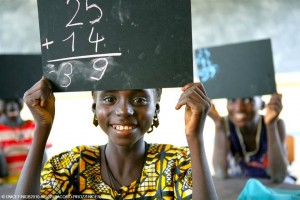
By Ban Ki-moon
These difficult financial times demand smart financial investments. And one of the soundest investments we can make is in girls – in educating them, empowering them and keeping them healthy.
Too many girls in too many countries are held back simply because of their gender, marginalized and deprived of control of their own destinies. They are disproportionately affected by poverty and exploitation. Too many are affected by violence. Too many lack access to basic health services. And too many are deprived of an education.
Today, there are 57 million children out of school – and most of them are girls.
While disturbing, this represents a huge opportunity – because we know, from indisputable experience, the benefits of investing in girls. And there is no more valuable investment than in a girl’s education.
When I discuss the transformational power of education, I do so from my own experience. In my small village in the Republic of Korea after the war, I had no textbooks, or even a school building. Our class gathered under a tree. But what we lacked in supplies, we made up for in our passion for learning. It was this thirst for education that lifted up my country and turned it into one of the world’s most powerful economies.
Educating girls and giving them the tools to shape their own future has an incredible multiplier effect on economic growth. It leads to increased prosperity not just for individuals but for their communities and their societies. It provides returns for decades.
For companies, educating girls helps build the skilled workforce needed to succeed in business. And investing in education creates a generation of people who will have rising incomes and demands for products and services – creating new markets and new opportunities for growth.
An extra year of primary school boosts girls’ productivity and eventual wages by 10 to 20 per cent. Women, the main caretakers of their children, tend to reinvest a staggering 90 per cent of what they earn into their families. This translates into an average GDP growth of 0.3 percentage points for each per cent increase in female education.
What’s more, educated girls tend to be healthier and have healthier children. Educated mothers are much more likely to survive childbirth. If we put all girls in primary school, we could save an estimated 189,000 women each year. If all women had schooling as girls, experts say we could save 900,000 of their children each year. And if those girls got a secondary education, we could save three million lives.
One in three girls in developing countries is married by age 18 – a serious threat to their lives, health and future prospects. With seven years of education, a girl marries on average four years later and has 2.2 fewer children.
Research has found that educated women experience less violence, and educated girls are less likely to undergo female genital mutilation – or subject their daughters to it. Educating girls also tends to promote their meaningful participation in politics and public life.
By any standards, this all represents a good return on investment.
So how can businesses help make the goal of educating all girls a reality? For one, we need the inventive thinking and pioneering spirit that so abounds in the private sector. Corporate philanthropy is critical, but we need more companies to think about how their business policies and practices can impact education priorities.
As a guide, the UN has developed a Framework for Business Engagement in Education to highlight the various ways companies big and small in diverse industries can lend their support. I encourage the private sector to make use of this tool.
Educating girls is a first step. Employers everywhere also need to take a long and hard look at how far gender equality has been achieved in every workplace, to ensure that women are not only recruited but given the opportunities that they deserve to advance their careers. At the same time, businesses should support working mothers, including through maternity leave and flexible work arrangements, including those that enable breastfeeding. This will boost morale and productivity while providing girls and boys with the best possible start in life.
We have seen the enormous mobilization that can be achieved through public-private partnerships, such as the Every Woman Every Child and the Global Education First initiatives that I have spearheaded.
But we need to go further.
That’s why this week at the World Economic Forum in Davos, I’m bringing together top mindsto look at innovative approaches to enable girls worldwide to learn, earn, thrive, and empower themselves and others. We will focus on how to ramp up progress through targeted investments and creative partnerships.
I was privileged to meet Malala Yousafzai, a young woman who almost died standing up for her right to go to school and who is now a dedicated campaigner for girls’ education.
Malala said that one child, one teacher, one pen and one book can change the world – that education is the only solution.
Let us heed Malala’s wise words. Invest in girls – and invest in our common future.
